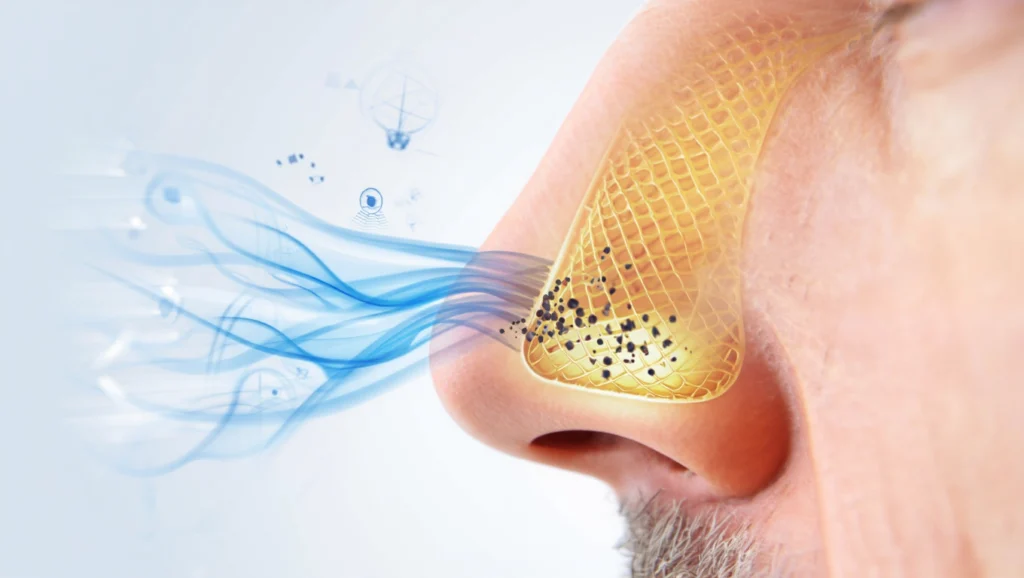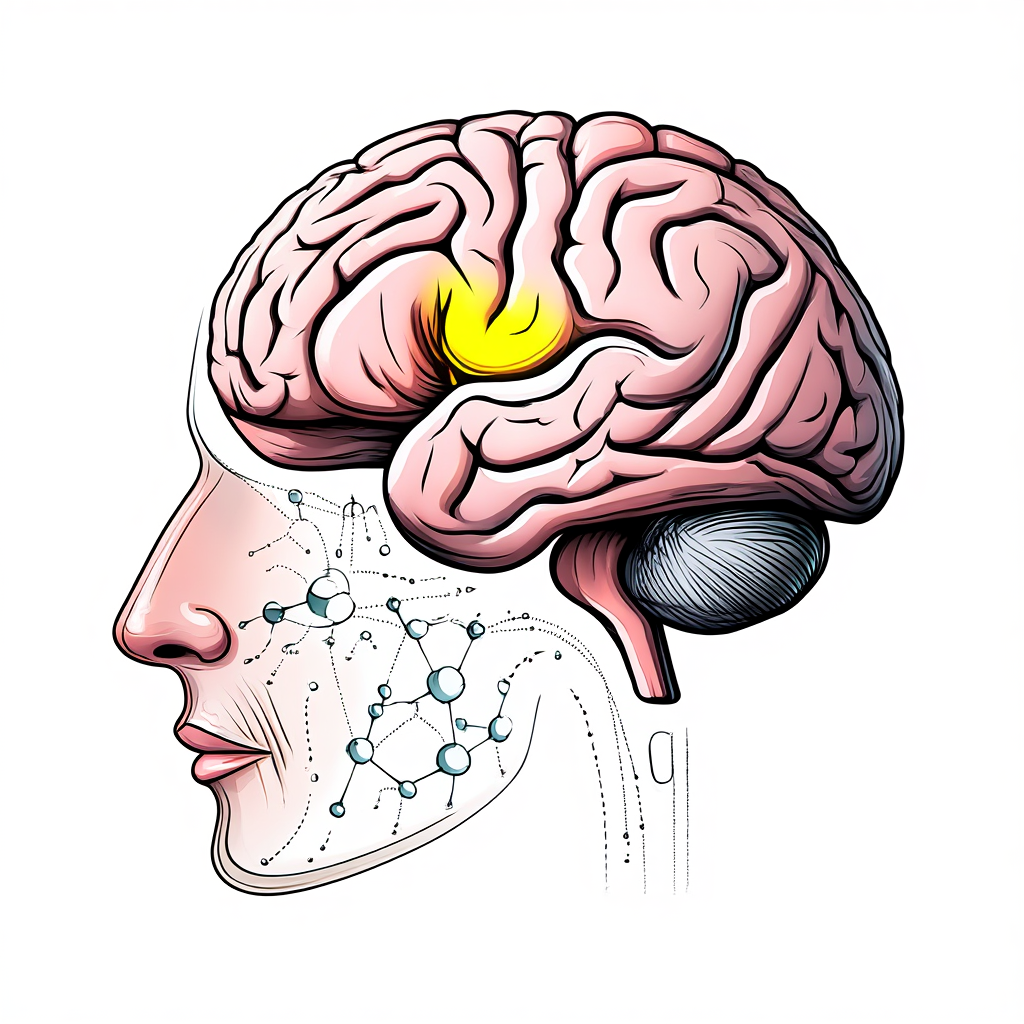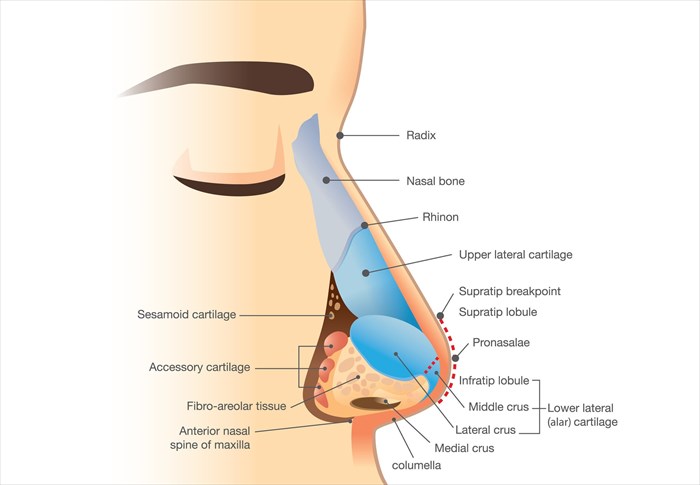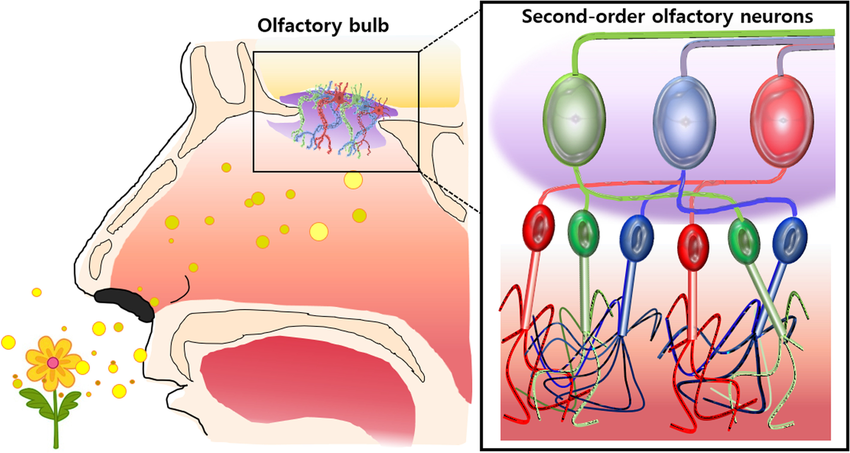Your nose is more than just a decoration for your face. It is important for breathing, filtering air, and smelling. It also plays a role in voice formation. I wonder how the nose works? This small but complex organ consists of cartilage, bones, and soft tissues that work together to keep you healthy. It warms and cleans the air you breathe, protects you from germs, and helps you perceive the world through your sense of smell. What is its structure and what everyday functions does it perform?
Anatomy of the Nose: Main Sections
Ever wonder what’s going on inside your nose? It’s not just a bump on your face—it’s packed with parts that team up to make how the nose works fascinating.
External Nose: The Part You See
Picture your nose from the outside. It’s built from bone at the top and softer cartilage below, shaping its unique look. The skin wraps around it, and those tiny hairs inside your nostrils? They kick off how the nose works by snagging dust before it sneaks further. Noses come in all shapes—broad, slim, or somewhere in between—but they all handle the same tasks. Blood vessels inside keep it warm, setting the stage for air exchange down the line.
Nasal Cavity: The Inner Workings
Step inside, and you’ll find the nasal cavity, the real star of how the nose works. This hollow chamber sits behind your nostrils, coated with a sticky nasal lining that traps dirt and germs. A thin wall, called the septum, splits it into two passages. Curved bony shelves, known as turbinates, jut out into each passage. They swirl the air, warming and cleaning it before it hits your lungs, a core part of nasal functions.
Sinuses: The Hidden Chambers
Your sinuses are like secret hideouts around the nasal cavity. Tucked in your cheeks, forehead, and between your eyes, these air-filled pockets lighten your skull and give your voice its unique twang. They also churn out mucus to keep your nose moist, a key piece of nasal functions. Blocked sinuses? That’s when you feel that stuffy pressure. It’s wild how these hidden spaces tie into how the nose works, like a backstage crew for your breathing.

The Nose’s Role in Breathing and Protection
Think of your nose as your body’s air purifier, a big part of how the nose works. It’s always on duty, making sure you breathe clean, warm air. Here’s how it nails those nasal functions with style.
- Air filtration: Tiny hairs and mucus in the nasal lining grab dust, pollen, and germs. It’s like a trap for airborne junk.
- Warming and humidifying: Cold, dry air gets warmed and moistened as it flows through. The turbinates and blood vessels make it happen.
- Protection: The nose stops harmful stuff from hitting your lungs. Sneezing blasts out intruders like a bouncer at a club.
- Voice resonance: Sinuses shape your voice’s unique sound. Ever sound off when you’re stuffed up?
Air Exchange: How It Flows
Ever notice how smoothly you breathe through your nose? That’s air exchange working like a charm, showing how the nose works in action. Air swirls through the turbinates when you inhale, slowing down so the nasal lining can warm and clean it. Exhaling follows the same path, keeping your lungs happy. The septum balances airflow between the two passages. If one gets clogged, breathing feels off—a clear sign of nasal functions doing their thing.
Immune Defense: The Nose as a Gatekeeper
Your nose isn’t just for breathing—it’s a frontline guard, a huge part of its nasal functions. Mucus snares bacteria and viruses, while enzymes in it zap those germs. Sneezing and nose-blowing flush out the junk. Those tiny hairs in your nostrils? They catch big particles before they get far. Your nose is like a security checkpoint, keeping trouble out of your body and proving how the nose works to keep you safe.
How Smell Is Detected and Processed
The sense of smell is one of the nose’s slickest moves, central to how the nose works. It’s not just about sniffing fresh coffee from your local Starbucks—it’s linked to memory, taste, and even staying alive. Here’s how it pulls it off.
| Part of the Nose | Role in Smell |
| Olfactory Epithelium | A patch at the top of the nasal cavity with special cells that detect odors. |
| Olfactory Receptors | Tiny proteins in those cells that grab scent molecules. Each one picks up different smells. |
| Olfactory Bulb | A brain relay station that sorts and sends smell signals to other brain areas. |
| Brain Regions | Parts like the amygdala and hippocampus link smells to emotions and memories. |
Sniffing Out the Details
Catch a whiff of something? Tiny scent molecules ride the air into your nose, hitting the olfactory epithelium high up in the nasal cavity. Special cells there have receptors that latch onto those molecules. Each receptor is choosy, grabbing only specific scents. Those cells fire signals to the olfactory bulb in your brain, which sorts them and sends them to areas handling emotions and memories. That’s how the nose works to turn a sniff into a vivid experience.
Why Smell Matters
Your sense of smell does more than make food enjoyable. It warns you about danger—like smoke or spoiled food. It also ties to taste. Did you know that about 80% of what you taste comes from your sense of smell? Humans can detect over 10,000 different odors, and the olfactory system processes smells in just 100-200 milliseconds. The nose sends signals to your brain faster than you’d think, making split-second decisions about what’s safe or yummy. This is a huge part of how the nose works and why it’s so vital.
Why the Nose “Understands” Scents
Ever wonder how your nose sorts out a Thanksgiving pie from a wet dog? It’s like a master chef picking out every ingredient in a dish, a key piece of how the nose works. Here’s how it cracks the code on smells.
The Science of Scent Recognition
Your nose has around 400 types of scent receptors. Each one grabs different molecules, like puzzle pieces fitting together. Sniff a pumpkin spice latte, and tons of molecules hit those receptors, creating a unique “smell fingerprint.” Your brain reads it and goes, “Yup, that’s fall in a cup.” That precision in the sense of smell lets you pick out thousands of odors, showing off nasal functions at their best.
Factors That Shape Smell
A few things tweak how your nose handles scents. Here’s the breakdown:
- Genetics: Your DNA picks which receptors you’ve got. Some folks can’t smell certain things.
- Environment: Dusty air or city smog can dull your sense of smell. Fresh air keeps it sharp.
- Health: Colds, allergies, or aging can mess with your nose’s game.
- Training: Chefs and perfumers fine-tune their noses to catch subtle notes. Practice pays off.
Smell and Memory: The Connection
Smells hit your brain like no other sense. The olfactory bulb chats directly with the amygdala and hippocampus, tying scents to emotions and memories. Ever smell fresh-baked cookies and feel like you’re back at grandma’s house? That’s not random—it’s baked into how the nose works. Your nose acts like a time capsule, pulling up old feelings with one whiff, thanks to the power of the sense of smell.

Fun Facts: Why We Have Two Nasal Passages
Ever thought about why you’ve got two nostrils? It’s not just for symmetry. Those two nasal passages have clever reasons for being there, tying right into how the nose works.
The Nasal Cycle: Taking Turns
Your nose pulls a sneaky trick called the nasal cycle. One nasal passage takes charge for a few hours, handling most of the airflow, then hands off to the other. You barely notice since it’s so smooth, but it gives each side a breather. This keeps the nasal lining moist and ready for action. It’s like your nose is playing a tag-team match to keep nasal functions running smoothly.
Other Cool Reasons for Two Passages
Having two nasal passages isn’t just a backup plan. Check out the perks:
- Better air filtration: Two paths give more space to trap dust and germs.
- Balanced airflow: The septum splits air evenly, so neither side gets overworked.
- Smell precision: Each passage catches slightly different scent signals, feeding your brain extra info.
- Survival edge: If one side’s blocked, the other keeps you breathing and sniffing.
Two nostrils might seem simple, but they’re a genius design. Your nose is quietly crushing it, showing how the nose works in ways you’d never guess.
Your nose deserves a round of applause. It handles air exchange, keeps your lungs safe with killer air filtration, and powers your sense of smell to make life richer—think fresh coffee or a summer barbecue. From the nasal cavity to the nasal lining, every part plays a role in how the nose works. Those two nasal passages? They’re not just there for looks—they’re a smart setup for breathing and sniffing. Next time you catch a whiff of something great, tip your hat to your nose. It’s doing serious work behind the scenes, thanks to its slick nasal functions.





